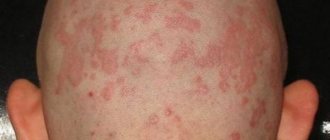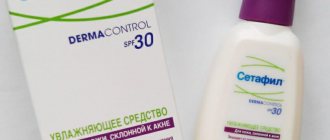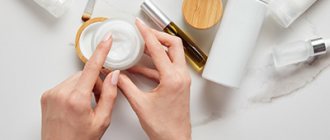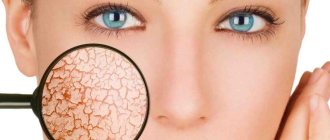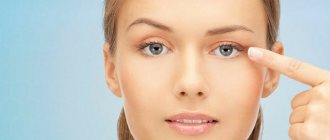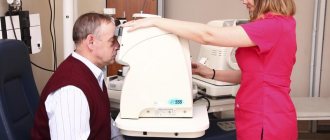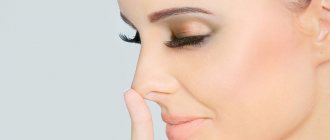Published: August 2, 2017
Human eyes are one of the most important and vulnerable organs; they are protected from the external environment for centuries; their skin is very thin and sensitive. Itching, redness or peeling of the upper eyelids occur quite often; about 10% of patients come to the ophthalmologist with this problem.
Many people ignore this symptom; of course, this is unacceptable. Redness and peeling of the eyelids may be a sign of a disease that leads to decreased visual acuity or complete loss.
Why does blepharitis occur?
Blepharitis can develop for many reasons. Among the main factors, doctors identify:
- viral infection;
- failure to comply with hygiene rules;
- demodicosis (Demodex mites);
- significant deterioration of immunity;
- the presence of other diseases of the organs of vision;
- presence of allergic diseases;
- chronic conjunctivitis and other inflammatory processes;
- constant exposure to irritating and damaging factors (dust, smoke, sand, dry air).
How to recognize blepharitis?
There are common symptoms of blepharitis. These include:
- photophobia;
- rapid eye fatigue when reading;
- feeling of heavy eyelids;
- swelling, redness (especially in the morning after waking up);
- thickening and swelling of the ciliary edge of the eyelids;
- feeling of “sand in the eyes”;
- itching;
- eyelash loss;
- the appearance of discharge and gluing of the eyelids;
- the appearance of dry crusts on the ciliary edge of the eyelids.
If one or more of these signs appears, you should contact an ophthalmologist to make an accurate diagnosis and prescribe the most effective treatment.
Prevention
Often, peeling and many ophthalmological disorders are easier to prevent than to eliminate later. To do this, you need to follow the following recommendations:
- exclude possible allergens;
- replace contact lenses on time (after any infectious diseases, be sure to purchase a new pair);
- use high-quality decorative cosmetics, cleansers and care products;
- remove makeup every evening;
- spend less time at the computer, take regular breaks from work;
- humidify the air in the room;
- do not touch your eyes with dirty hands.
Peeling skin can occur due to frequent stress or lack of vitamins. To prevent the problem, you need to eat foods that contain substances beneficial to the skin:
- dairy products;
- fish;
- liver;
- nuts;
- fresh seasonal fruits and vegetables;
- lean meat;
- liquid (pure water, herbal teas) in an amount of 2 liters per day.
To normalize your emotional state and sleep, it is recommended to drink tea with chamomile and mint, boiled milk with honey at night.
Excessive dryness and flaking of the skin on the upper eyelid is one of the signs of dysfunction of the body or visual system. This symptom cannot be ignored; if it occurs, it is necessary to change your diet, lifestyle and consult a specialist.
What types of blepharitis are there?
Based on clinical manifestations, experts distinguish several types of the disease:
- Simple. With this form of blepharitis, the eyelids thicken, a large amount of white-gray secretion accumulates in the corners of the eyes, and the ducts of the meibomian glands are dilated.
- Scaly. On the edge of the eyelids of a patient suffering from this form of the disease, scales similar to dandruff accumulate - parts of the epidermis that stick to the base of the eyelashes.
- Ulcerative. With ulcerative blepharitis, ulcers are formed on the edge of the eyelids, covered with yellow crusts. In the advanced form, after the ulcers heal, scars form that disrupt the growth of eyelashes.
- Rosacea. This form of blepharitis is characterized by the formation of red-gray nodules on the skin, often with ulcers.
- Demodectic. Blepharitis caused by mites of the genus Demodex occurs with unbearable itching, the release of a sticky secretion that dries on the eyelids, redness and thickening of the edges of the eyelids.
- Allergic. Blepharitis of this type is in all cases associated with exposure to an external factor – an allergen. With this form, the eyelids thicken, the skin darkens, there is pain in the eyes, photophobia, lacrimation, and mucous discharge may appear.
How is blepharitis treated?
If signs of blepharitis are detected, the eye doctor will select the optimal treatment regimen for you. Most likely, it will include a complex of both local and general measures that affect the condition of the body as a whole. Treatment will depend on the causes of blepharitis, severity and neglect. As a rule, it includes:
- cleansing the eyelids from crusts, scales, purulent discharge (eyelid hygiene);
- applying antibacterial ointments;
- the use of special eye drops with an antibiotic and antiseptic;
- the use of natural tear substitutes.
In some cases (with demodectic blepharitis), antiparasitic drugs are also used.
Treatment of dry eyelids
The tactics to combat dry eyelids depend on the causes of its occurrence. If it lies only in the initially dry skin type or is a consequence of the adverse influence of external factors, it is enough to organize proper eyelid care, avoid contact with aggressive environmental factors and, if necessary, carry out a course of cosmetic procedures.
But if the root of the problem lies in the development of dermatological diseases or disorders in the functioning of internal organs, longer and more complex treatment will be required. In such situations, it will always be comprehensive and aimed not only at moisturizing and nourishing the skin of the eyelids, but also at eliminating detected diseases.
In case of an allergic reaction, antihistamines or corticosteroids are prescribed.
Absolutely all patients who consult a dermatologist with the problem of dry eyelids are recommended to protect their eyes on sunny days, especially in summer, with sunglasses that completely cover the eyelids and protect them from the negative effects of ultraviolet rays, or to apply special sunscreens. It is also worth giving up bad habits, enriching your daily diet with sources of vitamins A, C, E and drinking at least 2 liters of water daily, in addition to other drinks.
Additionally, complex vitamin preparations are prescribed.
Home eyelid skin care
To avoid problems with the skin of the eyelids and the development of diseases, it is important to properly care for it. Dry eyelid skin first of all requires sufficient hydration and protection from external irritants. Therefore, cosmetologists recommend:
- Use only special makeup removers created taking into account the structure of the skin of the eyelids and avoid soap and alcohol lotions when washing. It is important to avoid intense friction and mechanical irritation. It is better to blot the skin with a soft cotton pad soaked in the product.
- Regularly use special creams, masks, serums for the area around the eyes containing humectants and physiological lipids. Do not apply them to the moving eyelid unless this option is written on the packaging. Most products are applied to the orbital bone.
- Apply the cream no later than 1-2 hours before bedtime. Otherwise, there is a high probability of bags under the eyes forming in the morning. The optimal time for eyelid skin care is considered to be from 19 to 22 hours.
- Under no circumstances should you use scrubs and peels to exfoliate the skin of your eyelids.
- Protect your eyes from contact with shampoo, shower gel, and facial cleansers.
Caring for dry skin, including eyelids, should always include 2 types of treatment: gentle cleansing and adequate moisturizing. To cleanse the skin, use soft, non-foaming products, such as micellar water or cold creams. They contain mineral oils, non-ionic detergents (esters and micelles of fatty acids), which carefully dissolve contaminants, including decorative cosmetics. At the same time, they are easily removed from the skin with a cotton pad and do not require friction. In addition, they do not remove natural lipids, in particular cerebrosides and ceramides, which is an additional plus.
In addition, we must not forget that the main cause of dry eyelids is the insignificant thickness of the lipid film and dehydration. Therefore, it is important to focus efforts on maintaining normal levels of moisture and lipids. For this purpose, it is recommended to use cosmetics containing physiological lipids and humectants (hydrants), in particular:
- fatty acids, ceramides, cholesterol;
- glycerin, waxes, mineral and natural oils;
- hyaluronic acid, urea, lactic acid, collagen.
To eliminate severe dry eyelids, you should choose masks and serums. In milder cases and to maintain healthy skin, creams are sufficient.
Humectants ensure that water present in the stratum corneum is introduced deep into the skin. These include: NMF, polyols, liposomes, glycosaminoglycans, elastin, collagen. The NMF system deserves special attention, which includes a variety of water-soluble and hydrophilic substances that are natural to the stratum corneum. One of the brightest representatives of such products is a composition based on pyrrolidonecarbolic acid, urea and lactic acid.
Substances that form a lipid film, on the contrary, help slow down the loss of water through the stratum corneum. These include all compounds that form the oil phase of any cream. This can be petroleum jelly, paraffin, silicones, natural oils rich in polyunsaturated fatty acids, lanolin.
For severe peeling, a dermatologist may recommend keratolytics. But they are used with caution.
Care products are selected individually, taking into account skin type, time of year and other factors. Thus, in late autumn and winter it is recommended to use products containing moisturizers, and in the summer you should avoid using creams containing comedogenic lipids. But the emphasis is always on the ability of an eyelid skin care product to create a protective film.
For atopic dermatitis, ichthyosis and many other dermatological diseases, the use of fatty creams of the “water in oil” type is indicated. Their distinctive feature is the distribution of a small amount of liquid components in a fatty dispersion medium. They effectively solve the problem of dry eyelid skin, loss of elasticity and help reduce superficial inflammatory processes.
It is important to correctly apply care products to both eyelids. This is done exclusively along massage lines with light, patting movements to prevent overstretching of the skin and to avoid premature formation of wrinkles. On the lower eyelid, the cream is applied from the outer corner of the eye towards the nose, and on the upper eyelid, on the contrary, from the nose to the outer corner of the eye.
Cosmetology procedures
Cosmetic procedures are carried out only if the development of dermatological diseases is excluded. Today, biorevitalization and mesotherapy are used to solve the problem of dry eyelids. These procedures involve the introduction of substances into the skin that help moisturize and nourish it.
If dry eyelids are the result of age-related changes, you can additionally fill the nasolacrimal groove and wrinkles around the eyes with fillers, i.e., contour plastic surgery. This will further achieve a pronounced anti-aging effect.
But any cosmetic procedures cannot be performed if:
- oncological diseases;
- exacerbation of herpetic infection;
- acute infectious disease or exacerbation of a chronic disease;
- pregnancy and lactation;
- autoimmune disorders.
Biorevitalization
Biorevitalization is a procedure that involves the introduction of hyaluronic acid into different layers of the skin through multiple point injections or non-injection methods. Patients should understand that biorevitalization does not provide an immediate effect. It increases smoothly within 2 weeks after the procedure and lasts for an average of 6-12 months.
To obtain a pronounced result, a course of procedures consisting of 3-5 sessions will be required. They are carried out at intervals of 2-4 weeks. The exact number of biorevitalization procedures required will be determined by a dermatocosmetologist individually based on the condition of the eyelid skin. In some cases, one course is enough to solve the problem of dry eyelids, while in others, maintenance procedures will be required, the frequency of which is also determined by the doctor for each patient separately.
Biorevitalization can be carried out by injection, but hardware techniques are more often used to treat the delicate skin of the eyelids. In the first case, the procedure involves introducing a specially selected hyaluronic acid preparation into the skin of the eyelid with thin needles. The minimum diameter of the needle ensures minor trauma to the skin and rapid recovery. Injections are performed at a distance of 1-1.5 cm from each other after preliminary cleansing and treating the skin with an antiseptic. To make the procedure less painful, an anesthetic is first applied.
Non-injection biorevitalization is more suitable for working with delicate eyelids. There are several methods for introducing hyaluronic acid into the skin, but most often a laser is used for this purpose. With its help, it is possible to achieve the most uniform distribution of the drug in the tissues and obtain a good moisturizing effect. In addition, it ensures that there are no visible marks on the skin around the eyes, which allows the procedure to be carried out during your lunch break and avoids the need to limit social contacts.
Laser biorevitalization additionally stimulates microcirculation, the synthesis of own collagen and elastin, and also reduces the severity of inflammatory processes.
Mesotherapy
Mesotherapy is very similar to biorevitalization, since it also involves the introduction of special preparations into the skin by injection or non-injection. But unlike biorevitalization, mesotherapy uses complex products containing not only hyaluronic acid, but also other compounds beneficial to the skin.
Preparations for mesotherapy are often called mesotherapy cocktails.
For dry eyelids, mesotherapy cocktails include:
- hyaluronic acid;
- vitamins;
- microelements;
- elastin;
- collagen.
Additionally, the procedure will help eliminate bags and bruises under the eyes, improve the condition of the skin in general and obtain a rejuvenating effect. But to get a good result, you also need to undergo a course of mesotherapy sessions.
